My MQ Quad comparison piece last week gave us a good overall view of its capabilities against similar Single Board Computers but how does it stand on its own? What (if anything) makes it special? By the end of this extended MangoPi MQ Quad Review hopefully, I’ll be able to tell you!
Table of Contents
MangoPi MQ Quad Specifications
| CPU | Allwinner H616 Quad-Core 1.5GHz Cortex A53 |
| RAM | 1024MB DDR3L RM |
| GPU | ARM Mali G31 MP2 |
| OpenGL 3.2 / Vulkan 1.1 | |
| Connectivity | TL8723DS 802.11 b/g/n (2.4GHz) WLAN |
| Bluetooth | |
| u.FL Antenna Connector (antenna included!) | |
| USB-C OTG (1) | |
| Mini HDMI (1) | |
| 18-pin MISC FFC connection (USB, Ethernet, GPIO) | |
| microSD Card Slot | |
| 40-pin Raspberry Pi compatible GPIO header | |
| Audio via audio out pads | |
| Power | AXP313 Power Management |
| USB-C (5v) | |
| via GPIO Header & POGO Pin | |
| Dimensions | 65x30mm (Length x Height) |
What’s in the box?
In a rather neat little plastic box (which a lot of manufacturers seem to be using these days, which I like!) you’ll find the MangoPi MQ Quad itself, a colour-coded 40-pin GPIO header (not soldered), a WiFi antenna, and a few teeny-weeny MangoPi stickers.
The board comes in an anti-static bag and is well packaged, with it wrapped in bubble wrap both inside and outside of the plastic box.
If you go for the heatsink add-on, this (at the time of writing) comes in a small thin polystyrene-ish bag to protect the rest of the consignment from flying lumps of metal and 2 plastic bags containing 4 thermal pads, 4 screws, and a mini hex/Allen key.
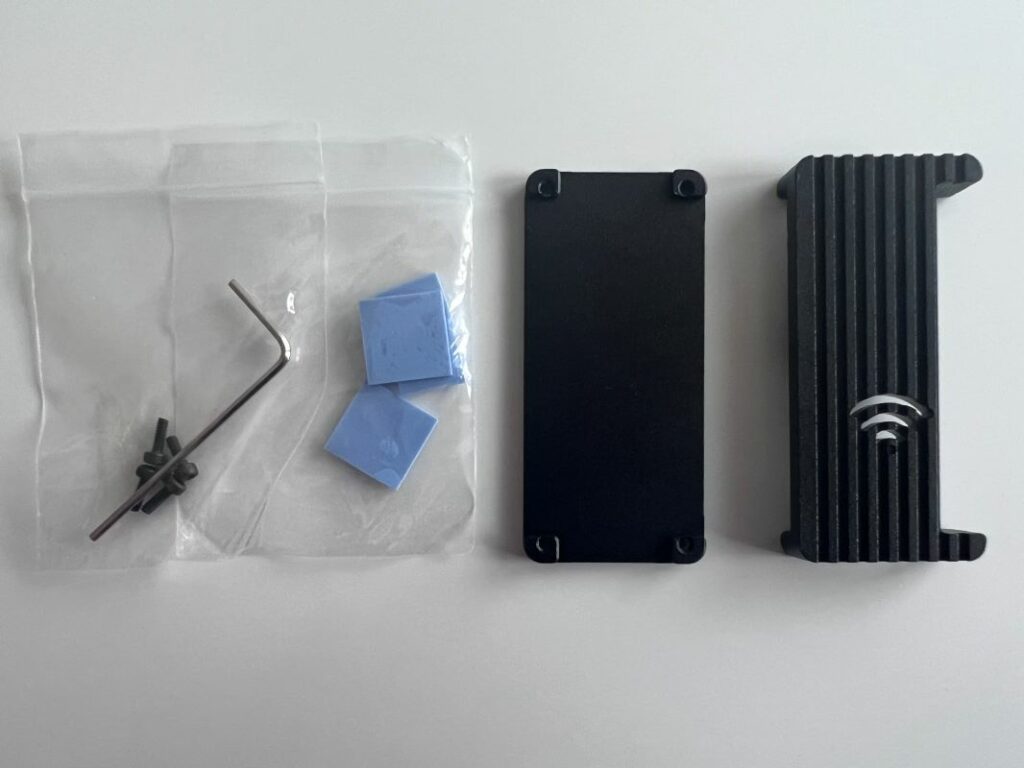
Is The Heatsink Worth Getting?
The option to add a heatsink for a couple of dollars is a welcome one, especially as the H616 can run on the warmer side without any assistance.
Unlike the Raspberry Pi and Orange Pi Heatsinks I tested recently, it’s clear that this was designed for another board and whilst the CPU “block” does line up, the included thermal pads are a bit of a problem.
It comes with 2 small and 2 larger square pads. The 2 larger ones are a little thinner than the smaller ones and that’s odd, as the large ones are the only ones that cover the SoC itself and they’re actually so thin that they don’t make contact with the CPU block. The thinner, larger ones do make contact if you put them over the RAM chip so you’d have to cut them to size if you don’t want excess.
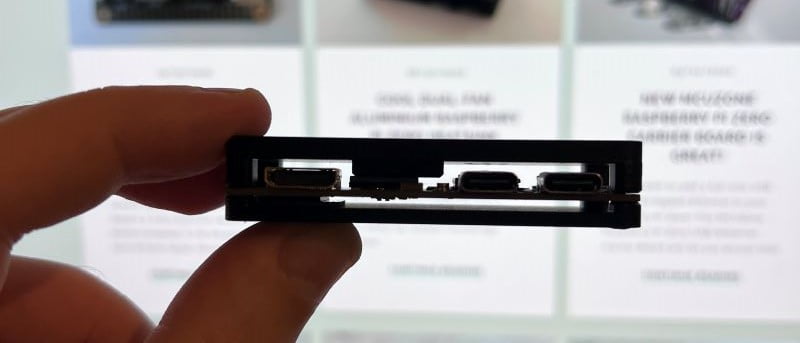
Saying that though, if you look at the above photo, once you have the smaller, thicker pad on it doesn’t cover the entirety of the SoC and once you mount the heatsink it doesn’t quite line up. That and you can see the clear gap where the pad doesn’t cover the entirety of the H616 hiding under there.
I’ve gone on too much about the heatsink now considering it’s an optional extra that costs only $2-3 but I have to sum it up as a good idea that could have been executed better. Thermal pads aren’t too expensive so having a heatsink where the thermal pad is too small and not utilising the CPU block to its full potential seems a waste. Hopefully, they can save money by sourcing a heatsink without the 4 unneeded pads and including 2 that are proportioned a little better.
How do Similar Boards Compare?
Utilising the Allwinner H616 SoC, it’s most similar to the OrangePi Zero 2 with a 1.5GHz Quad-Core Cortex A53 CPU and 1GB of DDR3 RAM so you’ll likely find me comparing it a lot in comments throughout. If you’re interested in seeing how it compares to other Raspberry Pi Zero-style boards then do check out my MangoPi MQ Quad Comparison piece.
In general though (spoiler alert if you haven’t read the above comparison yet) you’re going to see much the same performance from the MQ Quad as you do the Orange Pi Zero 2. The difference will be in the WiFi/Bluetooth, the form factor, software support etc.
Software Support
This is a subject that plagues the single-board computer world. We have lots of interesting boards but (most of) the manufacturers rely extremely heavily on community support such as Armbian to build, maintain, and distribute images. MangoPi hasn’t exactly been an exception to this as it took an Armbian forum member creating Debian/Ubuntu-based images (including desktop flavours) for people to be able to get up and running with the MQ Pro before Canonical released Ubuntu images for the closely-related Nezha D1 board that were semi-usable too.
As it stands, your best option for a ready-made image is the Debian image they link to on their MQ Quad product page which includes a desktop environment and was built for the OrangePi Zero 2. It’s the image I used for my testing, though I ripped out all of the desktop parts of it so it was mostly just clean Debian 11 (Bullseye) running the 5.16.17-sun50iw9 kernel.
Even then, Bluetooth doesn’t work so if you want that, you’re out of luck and your best option is going to try and build something with TinaLinux yourself and hope that the Gods are on your side and everything will work as expected. You can see the full documentation available on the MangoPi MQ Quad product page.
It’s rant time..
Isn’t it time we started wanting more from single-board computer manufacturers? I don’t know about you guys but I’d rather pay an extra $5-10 for a board if that money was going into software development. Instead of pumping out 6 new boards a year on old Allwinner chips, put some more time into making sure you’re picking the right hardware combinations, ask your communities for their thoughts, and put some money into the software side of things.
This isn’t necessarily a rant at MangoPi themselves as they’re a very small outfit of 1 person (?) that seems to be doing this as a passion project so maybe this should be its own piece but especially in this day and age, how many people have you spoken to about Raspberry Pi alternatives, only for them to throw the support issues back at you.
It’s likely been said over and over so this will likely fall on deaf Shenzhen-based ears but one can hope, right?
Compute Benchmarks
I won’t go into each individual benchmark in the compute section (unless you really want me to? Let me know in the comments..) as it feels like I’d bore you to death. For this piece, I’ve also included some additional tests from sbc-bench to cover a few more bases.
In nearly every benchmark you’re going to be seeing around twice the performance of the Raspberry Pi Zero 2 which means this could be an incredible value board for those wanting a more powerful replacement with a bit more RAM.
Do note that as usual, all of these compute tests were performed with the MangoPi MQ Quad raised up with a 120mm fan blowing air across the board to prevent thermal throttling (and at no point did the chip throttle) so in your real-world situations, your results may differ. This is meant to be a best-case scenario where the environment isn’t a limiting factor.
UnixBench
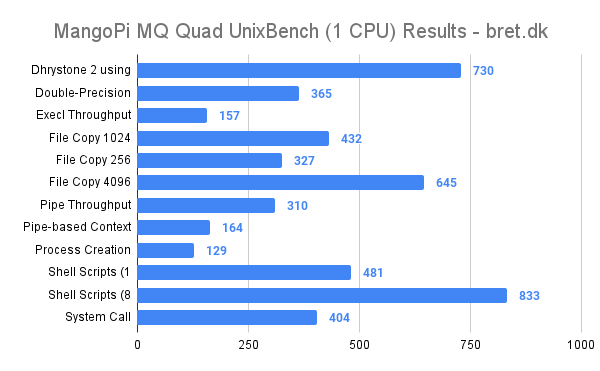

GeekBench 5.4 (AArch64)

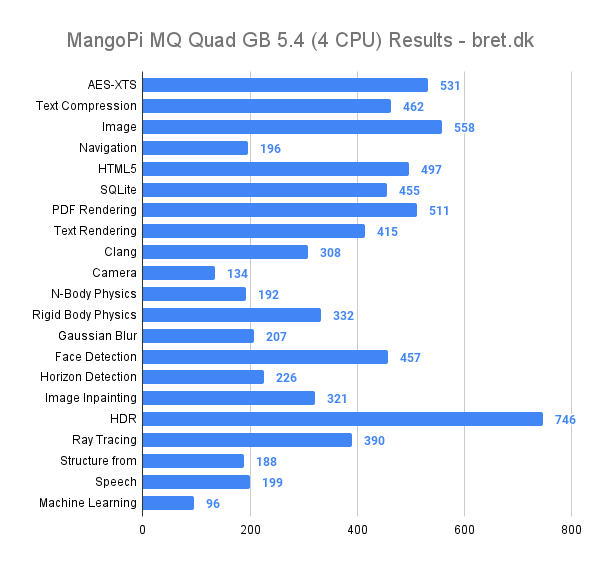
GeekBench 2.4.2 (ARMhf)
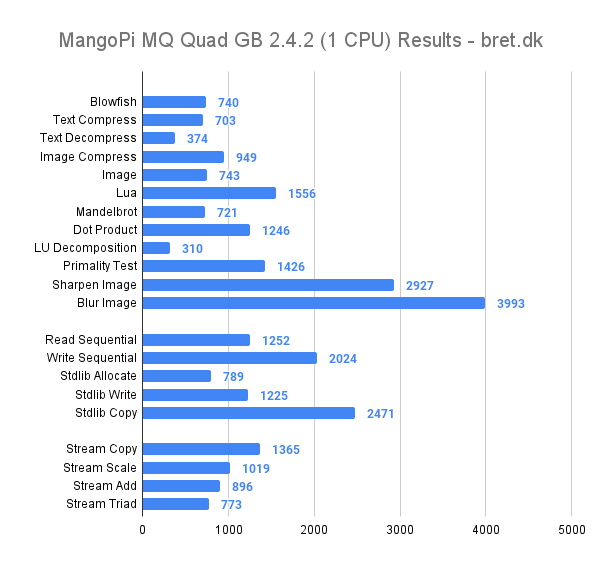
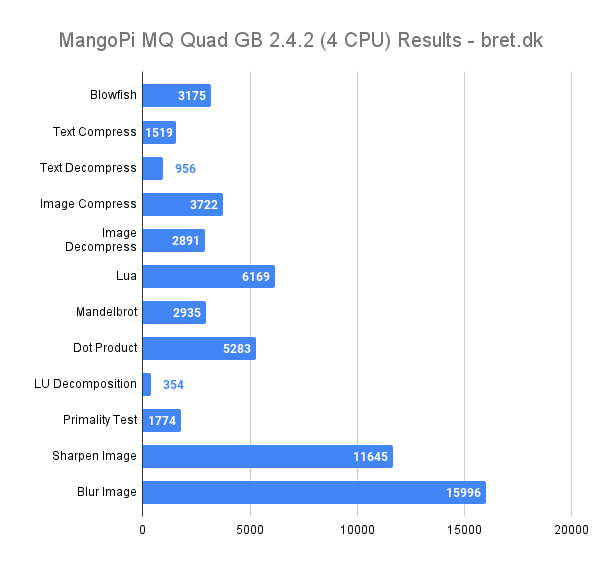
GZIP Compression

PyBench

PHPBench

WavPack Audio Encoding

Crypto++
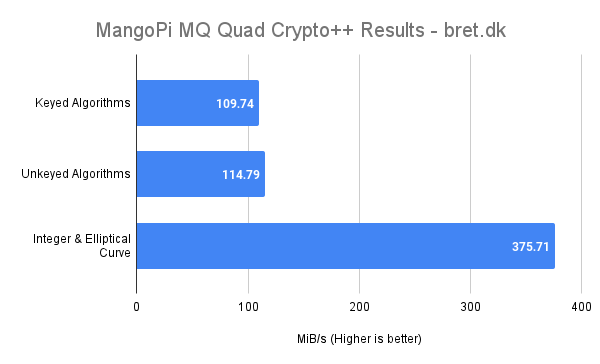
CacheBench
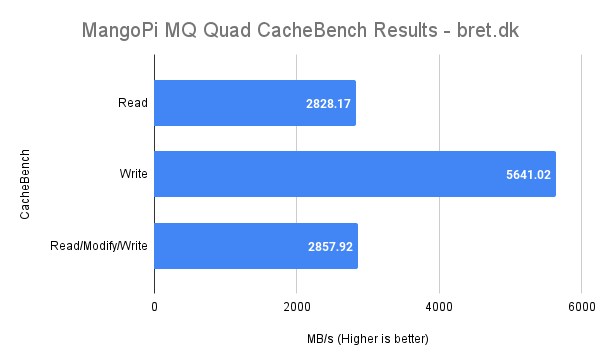
tinymembench
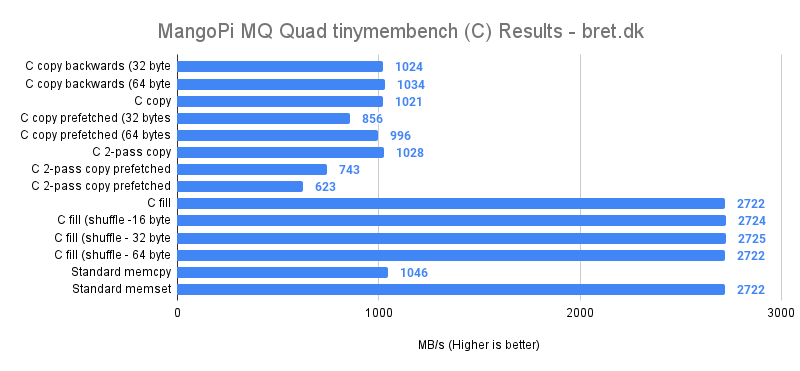

OpenSSL Benchmark
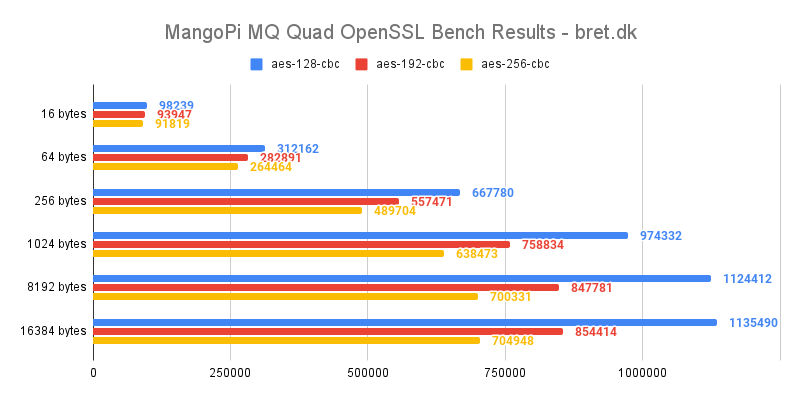
Storage (microSD/SSD) Performance
The Amazon Basics microSD card comes out on top yet again in most tests when you look at the raw numbers but that’s beside the point.. I’m happy to see that the MQ Quad’s microSD card performance is on par with the other boards in this Pi Zero style.
My trusty SATA to USB adapter gets another outing just to see how the USB performance on the MangoPi MQ Quad fared and as always, yes, it’s faster but at the cost of having a chonker of a disk hanging off your otherwise tiny SBC. If you’re into that kind of thing then sure, why not?
If you pick a quality microSD card, make a few adjustments to how you run your operating system (log2ram comes to mind), and refrain from yanking the power cable out 300 times a day then you’re going to be fine in most cases.
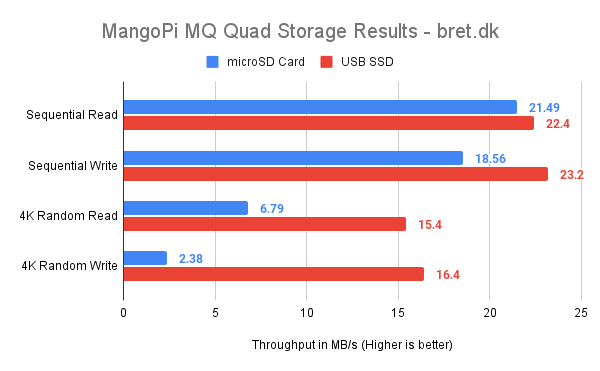
| SD Card Model | Sequential Read | Sequential Write | Random Read | Random Write | IOPing |
|---|---|---|---|---|---|
| SanDisk Ultra (8GB) | 12.77 MB/s | 13.27 MB/s | 5.47 MB/s | 0.63 MB/s | 0.84 ms |
| SanDisk Ultra (16GB) | 22.62 MB/s | 14.6 MB/s | 6.94 MB/s | 2.38 MB/s | 2.62 ms |
| SanDisk Ultra (32GB) | 22.63 MB/s | 18 MB/s | 7.18 MB/s | 2.08 MB/s | 2.65 ms |
| SanDisk Extreme (64GB) | 22.65 MB/s | 22.1 MB/s | 6.21 MB/s | 3.48 MB/s | 0.68 ms |
| SanDisk Extreme PRO (128GB) | 22.56 MB/s | 22.15 MB/s | 5.37 MB/s | 3.65 MB/s | 0.7 ms |
| Kingston Canvas Select Plus (32GB) | 11.4 MB/s | 9.6 MB/s | 4.97 MB/s | 1.94 MB/s | 0.73 ms |
| KIOXIA EXCERIA (32GB) | 22.63 MB/s | 15.4 MB/s | 9.32 MB/s | 4.13 MB/s | 0.65 ms |
| Samsung EVO Plus (32GB) | 22.31 MB/s | 18.6 MB/s | 6 MB/s | 1.25 MB/s | 1.21 ms |
| Amazon Basics (64GB) | 22.78 MB/s | 22.4 MB/s | 10.05 MB/s | 4.47 MB/s | 0.96 ms |
| Verbatim Premium (16GB) | 22.61 MB/s | 11.8 MB/s | 8.29 MB/s | 2.38 MB/s | 0.8 ms |
| SanDisk MAX ENDURANCE (32GB) | 22.5 MB/s | 21.75 MB/s | 5.97 MB/s | 3.43 MB/s | 0.62 ms |
| Integral ultima PRO (64GB) | 22.82 MB/s | 22 MB/s | 8.81 MB/s | 3.78 MB/s | 1.05 ms |
| Patriot EP Series (64GB) | 22.63 MB/s | 19 MB/s | 7.16 MB/s | 2.37 MB/s | 0.71 ms |
| Kodak (64GB) | 22.54 MB/s | 19.6 MB/s | 3.53 MB/s | 0.74 MB/s | 0.78 ms |
| Intenso (64GB) | 22.78 MB/s | 22.05 MB/s | 9.81 MB/s | 3.78 MB/s | 0.95 ms |
| Transcend (32GB) | 22.61 MB/s | 13.3 MB/s | 8.96 MB/s | 2.44 MB/s | 0.59 ms |
| Samsung EVO Select (32GB) | 22.51 MB/s | 19.9 MB/s | 6.18 MB/s | 1.14 MB/s | 1.01 ms |
| Samsung PRO Plus (128GB) | 22.58 MB/s | 20.25 MB/s | 7.27 MB/s | 1.16 MB/s | 0.69 ms |
| SanDisk HIGH ENDURANCE (64GB) | 22.42 MB/s | 21.15 MB/s | 4.78 MB/s | 2.5 MB/s | 0.69 ms |
| Samsung PRO Endurance (32GB) | 22.54 MB/s | 21.1 MB/s | 6.15 MB/s | 1.54 MB/s | 0.78 ms |
Network Benchmarks
To cover as many bases as possible, I’ve tested WiFi with a 3-metre line-of-sight across the room and will include tests for the bare board with and without a heatsink, along with the results from the included antenna again, with and without the heatsink. As always, tests were performed using iperf3 with 8 parallel threads over 5 minutes.
USB Ethernet was tested to both check the USB port and let you know what to expect should that be something you’re interested in. The Linksys 1Gbit USB Ethernet Adapter used resulted in 316Mbit/s downloads and 319Mbit/s downloads.
In terms of hardware, the MangoPi MQ Quad offers the same TL8723DS 802.11 b/g/n (2.4GHz) WiFi/Bluetooth combo chip as the MQ Pro so performance will be similar, albeit with the MQ Quad having a bit more processing grunt. Do note that at the moment there are no ready-to-go images with Bluetooth support.
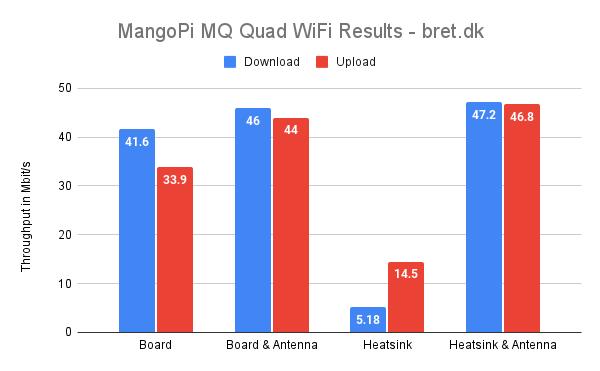
I also tested the difference between link quality and signal levels when you add the included WiFi antenna using wavemon. There’s a 23% increase in both under these test conditions so that’s definitely a welcome addition. Adding the antenna boosts your link quality from 69% to 87% and the signal level from -62 to -49. That 23% increase translates into around 160% faster download speeds (from 5.18Mbit/s to 47.2Mbit/s) when using the heatsink!
Temperatures
I’ve spoken at length about the included heatsink but just how well does it actually perform? The answer is, well, it’s OK. After 30 minutes of stress-ng hitting all 4 cores, we maxed out at 75.3 degrees which was just enough for it to drop from 1.51GHz to 1.21GHz at times.
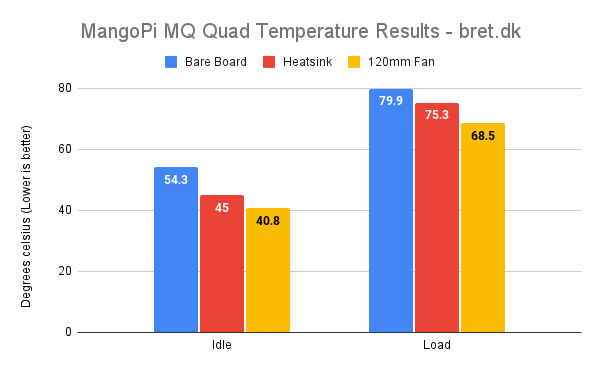
Power Consumption
Given that there are 4 Cortex-A53 cores in here running at 1.5GHz, it wasn’t going to be the most economical of boards (that feels crazy to say given the numbers below but stay with me) but under full load, the MangoPi MQ Quad power consumption sits at 2.21watts (0.431A at 5.12V). When sitting doing nothing but looking pretty, you’ll see around 0.97 watts (0.189A at 5.12V) of power drawn.

Where Can I Buy One?
The best place to buy the MangoPi MQ Quad will be the DongshanPi store on AliExpress where they’re currently available for around $25-26USD. This is the store that MangoPi has decided to sell through officially so don’t buy them from the resellers with massive markups! At the time of writing, they seem to be sold out of the heatsinks but hopefully, they get those back in stock soon (or a slightly different one). Do also make sure to select the MQ Quad as there’s an MCore board on the same listing.
Is It Worth It?
At $ 25.76 USD (roughly, excluding VAT/tax and shipping) it’s just over $10 USD more than the Raspberry Pi Zero 2’s retail price (if you can find one) which makes it a pretty interesting option. When you factor in tax and shipping you’ll probably be looking at a bit more than double the price of the Pi Zero 2 but do you know what’s cool about a bit more than double? That’s also how much more computing performance you’ll be getting out of it. You’ll also get double the RAM (1GB on the MangoPi MQ Quad vs 512MB on the Raspberry Pi) and it’s DDR3 vs DDR2 too!
This all sounds great! Why aren’t we all rushing out to buy the MQ Quad then? Well, there’s a little thing called software support that likes to get in the way and based on the big section on that further up, it’s a bit of a mood killer.. It’s best I round this up here before I get ranting again.
It’s a great SBC with interesting hardware, a performant SoC, and a fun form factor. If you’ve been using boards from the likes of OrangePi, BananaPi, and others and you’re comfortable with downloading a random image from Baidu or Google Drive with random features not working then you’ll feel right at home.